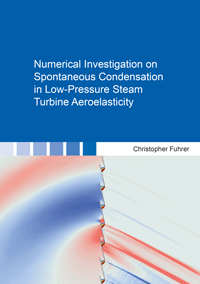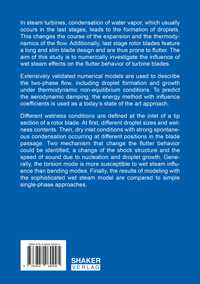
Shop : Details
Shop
Details
48,80 €ISBN 978-3-8440-8099-5Softcover176 pages88 figures260 g21 x 14,8 cmEnglishThesis
July 2021
Christopher Fuhrer
Numerical Investigation on Spontaneous Condensation in Low-Pressure Steam Turbine Aeroelasticity
In steam turbines, condensation of water vapor, which usually occurs in the last stages, leads to the formation of droplets. This changes the course of the expansion and the thermodynamics of the flow. Additionally, last stage rotor blades feature a long and slim blade design and are thus prone to flutter. The aim of this study is to numerically investigate the influence of wet steam effects on the flutter behavior of turbine blades.
Extensively validated numerical models are used to describe the two-phase flow, including droplet formation and growth under thermodynamic non-equilibrium conditions. To predict the aerodynamic damping, the energy method with influence coefficients is used as a today's state of the art approach.
Different wetness conditions are defined at the inlet of a tip section of a rotor blade. At first, different droplet sizes and wetness contents. Then, dry inlet conditions with strong spontaneous condensation occurring at different positions in the blade passage. Two mechanism that change the flutter behavior could be identified, a change of the shock structure and the speed of sound due to nucleation and droplet growth. Generally, the torsion mode is more susceptible to wet steam influence than bending modes. Finally, the results of modeling with the sophisticated wet steam model are compared to simple single-phase approaches.
Extensively validated numerical models are used to describe the two-phase flow, including droplet formation and growth under thermodynamic non-equilibrium conditions. To predict the aerodynamic damping, the energy method with influence coefficients is used as a today's state of the art approach.
Different wetness conditions are defined at the inlet of a tip section of a rotor blade. At first, different droplet sizes and wetness contents. Then, dry inlet conditions with strong spontaneous condensation occurring at different positions in the blade passage. Two mechanism that change the flutter behavior could be identified, a change of the shock structure and the speed of sound due to nucleation and droplet growth. Generally, the torsion mode is more susceptible to wet steam influence than bending modes. Finally, the results of modeling with the sophisticated wet steam model are compared to simple single-phase approaches.
Keywords: steam turbine; flutter; aerodynamic damping; cfd; condensation; aeromechanics; flutter prediction; low-pressure turbine; last stage
Available online documents for this title
You need Adobe Reader, to view these files. Here you will find a little help and information for downloading the PDF files.
Please note that the online documents cannot be printed or edited.
Please also see further information at: Help and Information.
Please also see further information at: Help and Information.
| Document |  | Document | ||
| Type |  | |||
| Costs |  | 36,60 € | ||
| Action |  | Purchase in obligation and download the file | ||
| Document |  | Table of contents | ||
| Type |  | |||
| Costs |  | free | ||
| Action |  | Download the file | ||
User settings for registered online customers (online documents)
You can change your address details here and access documents you have already ordered.
User
Not logged in
Export of bibliographic data
Shaker Verlag GmbH
Am Langen Graben 15a
52353 Düren
Germany
Am Langen Graben 15a
52353 Düren
Germany
Mon. - Thurs. 8:00 a.m. to 4:00 p.m.
Fri. 8:00 a.m. to 3:00 p.m.
Fri. 8:00 a.m. to 3:00 p.m.
Contact us. We will be happy to help you.



